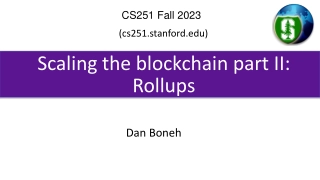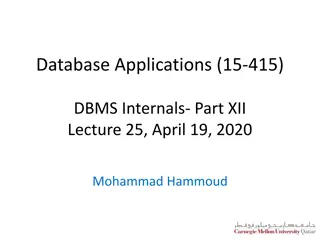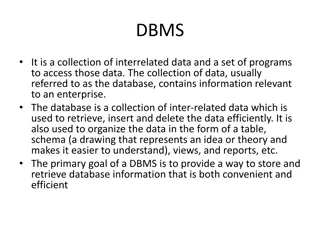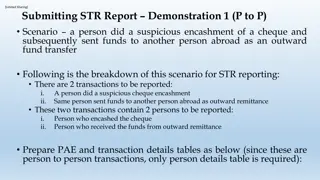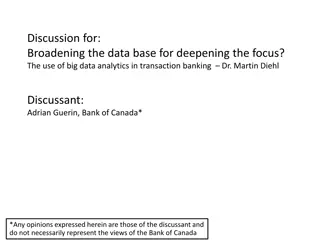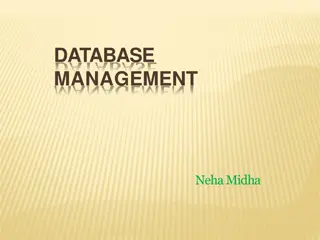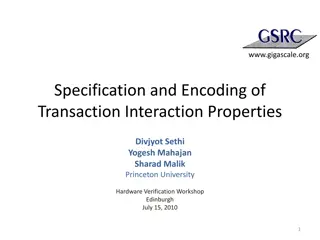
Database Management System: Transactions, Normalization, and More
Explore the concepts of transaction and concurrency management, normalization theory, functional dependencies, Boyce-Codd Normal Form (BCNF), and Third Normal Form (3NF) in database systems as discussed by H.K. Sharma, Associate Professor at Ehsan College of Engineering.
Download Presentation

Please find below an Image/Link to download the presentation.
The content on the website is provided AS IS for your information and personal use only. It may not be sold, licensed, or shared on other websites without obtaining consent from the author. If you encounter any issues during the download, it is possible that the publisher has removed the file from their server.
You are allowed to download the files provided on this website for personal or commercial use, subject to the condition that they are used lawfully. All files are the property of their respective owners.
The content on the website is provided AS IS for your information and personal use only. It may not be sold, licensed, or shared on other websites without obtaining consent from the author.
E N D
Presentation Transcript
ESHAN COLLEGE OF ENGINEERING Database Management System PPT s On Transaction Prepared By: H.K.Sharma, Associate Professor, CS Department,Ehsan College Of Engineering H.K.Sharma,CS Department
ESHAN COLLEGE OF ENGINEERING Transaction Management What if the system fails? What if more than one user is concurrently updating the same data? A transaction is a collection of operations that performs a single logical function in a database application Transaction-management component ensures that the database remains in a consistent (correct) state despite system failures (e.g., power failures and operating system crashes) and transaction failures. Concurrency-control manager controls the interaction among the concurrent transactions, to ensure the consistency of the database. H.K.Sharma,CS Department
ESHAN COLLEGE OF ENGINEERING Normalization Theory Decide whether a particular relation R is in good form. In the case that a relation R is not in good form, decompose it into set of relations {R1, R2, ..., Rn} such that Each relation is in good form The decomposition is a lossless decomposition Our theory is based on: Functional dependencies Multivalued dependencies H.K.Sharma,CS Department
ESHAN COLLEGE OF ENGINEERING Functional Dependencies There are usually a variety of constraints (rules) on the data in the real world. For example, some of the constraints that are expected to hold in a university database are: Students and instructors are uniquely identified by their ID. Each student and instructor has only one name. Each instructor and student is (primarily) associated with only one department. Each department has only one value for its budget, and only one associated building. H.K.Sharma,CS Department
ESHAN COLLEGE OF ENGINEERING Boyce-Codd Normal Form A relation schema R is in BCNF with respect to a set F of functional dependencies if for all functional dependencies in F+ of the form where R and R,at least one of the following holds: is trivial (i.e., ) is a superkey for R H.K.Sharma,CS Department
ESHAN COLLEGE OF ENGINEERING Third Normal Form A relation schema R is in third normal form (3NF) if for all: in F+ at least one of the following holds: is trivial (i.e., ) is a superkey for R Each attribute A in is contained in a candidate key for R. (NOTE: each attribute may be in a different candidate key) If a relation is in BCNF it is in 3NF (since in BCNF one of the first two conditions above must hold). Third condition is a minimal relaxation of BCNF to ensure dependency preservation (will see why later). H.K.Sharma,CS Department
ESHAN COLLEGE OF ENGINEERING 3NF Example dept_advisor(s_ID, i_ID, dept_name) With function dependencies: i_ID dept_name s_ID, dept_name i_ID Two candidate keys = {s_ID, dept_name}, {s_ID, i_ID } We have seen before that dept_advisor is not in BCNF R, however, is in 3NF s_ID, dept_name is a superkey i_ID dept_nameand i_ID is NOT a superkey, but: { dept_name} {i_ID } = {dept_name } and dept_name is contained in a candidate key Consider a schema: H.K.Sharma,CS Department
ESHAN COLLEGE OF ENGINEERING Redundancy in 3NF Consider the schema R below, which is in 3NF R = (J, K, L ) F = {JK L, L K } And an instance table: What is wrong with the table? where there is no corresponding value for J) Repetition of information Need to use null values (e.g., to represent the relationship l2, k2 H.K.Sharma,CS Department
ESHAN COLLEGE OF ENGINEERING Comparison of BCNF and 3NF Advantages to 3NF over BCNF. It is always possible to obtain a 3NF design without sacrificing losslessness or dependency preservation. Disadvantages to 3NF. We may have to use null values to represent some of the possible meaningful relationships among data items. There is the problem of repetition of information. H.K.Sharma,CS Department
ESHAN COLLEGE OF ENGINEERING Goals of Normalization Let R be a relation scheme with a set F of functional dependencies. Decide whether a relation scheme R is in good form. In the case that a relation scheme R is not in good form, need to decompose it into a set of relation scheme {R1, R2, ..., Rn} such that: Each relation scheme is in good form The decomposition is a lossless decomposition Preferably, the decomposition should be dependency preserving. H.K.Sharma,CS Department
ESHAN COLLEGE OF ENGINEERING Concurrency Control vs. Serializability Tests Concurrency-control protocols allow concurrent schedules, but ensure that the schedules are conflict/view serializable, and are recoverable and cascadeless . Concurrency control protocols (generally) do not examine the precedence graph as it is being created Instead a protocol imposes a discipline that avoids non-serializable schedules. We study such protocols in Chapter 16. Different concurrency control protocols provide different tradeoffs between the amount of concurrency they allow and the amount of overhead that they incur. Tests for serializability help us understand why a concurrency control protocol is correct. H.K.Sharma,CS Department

